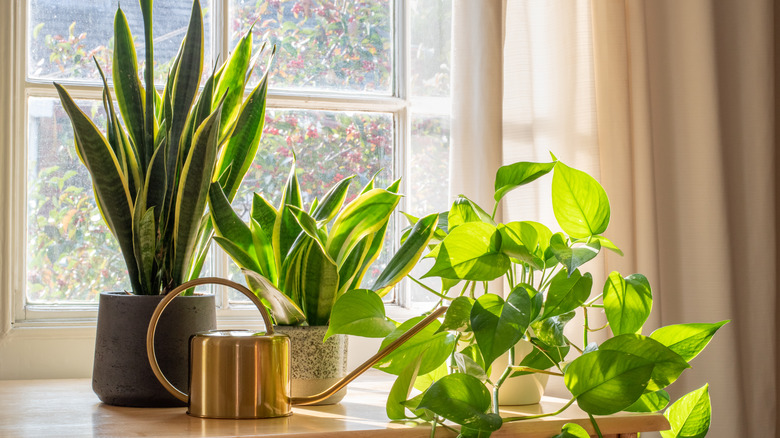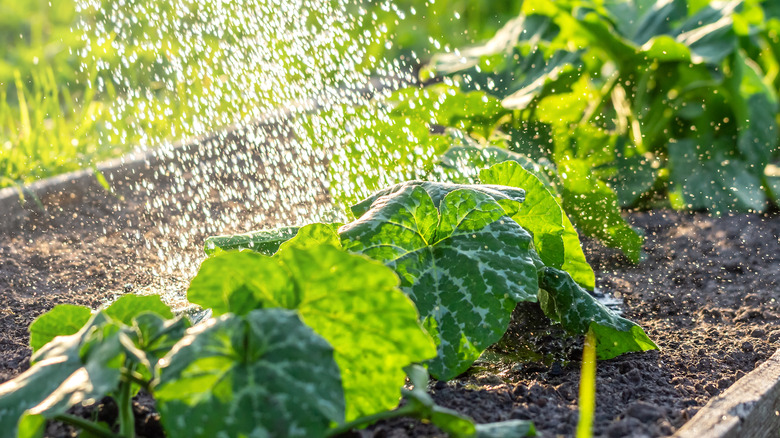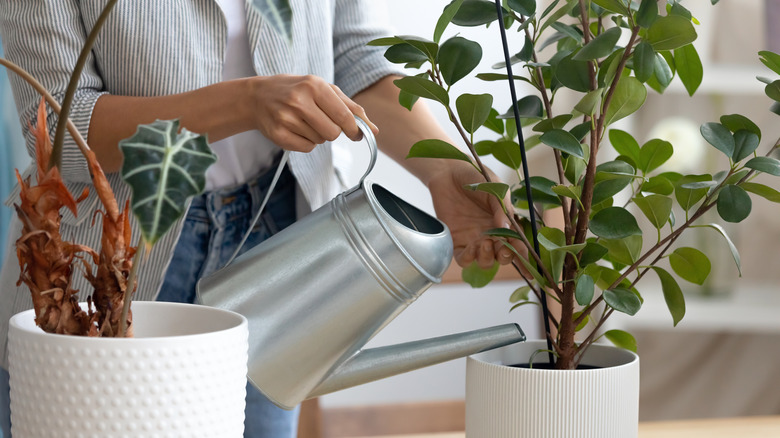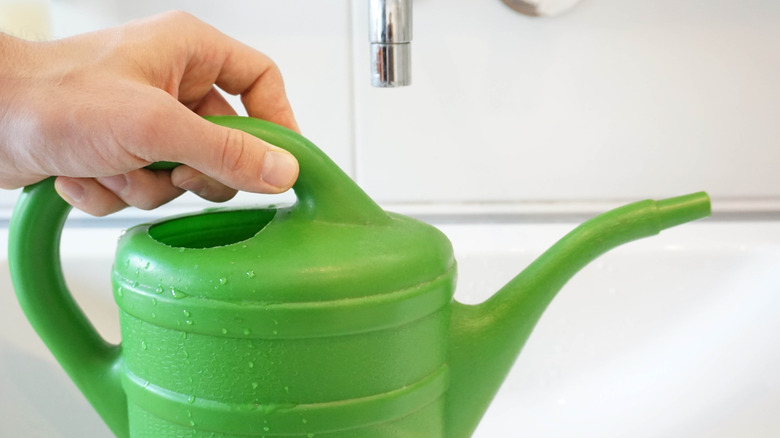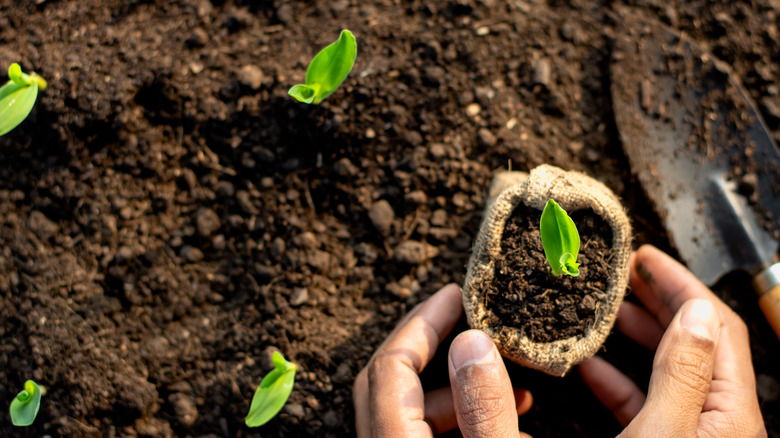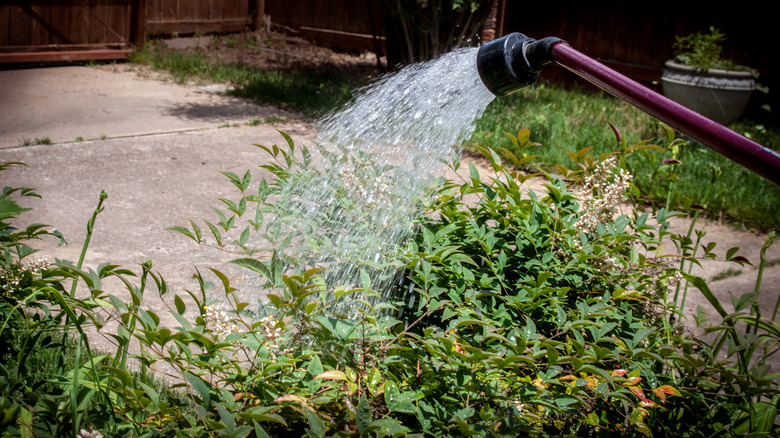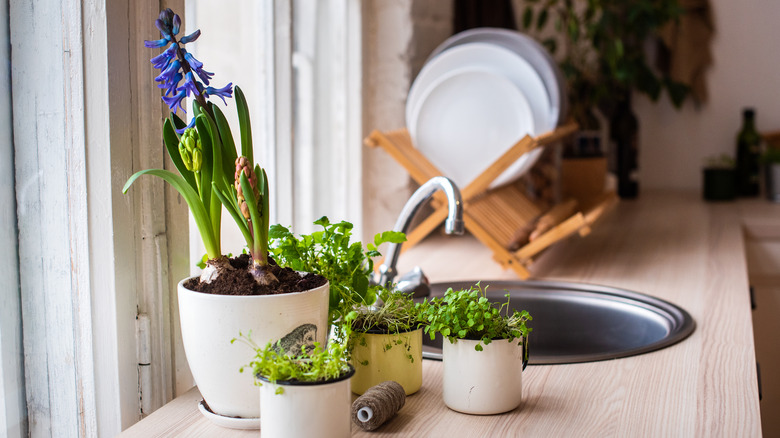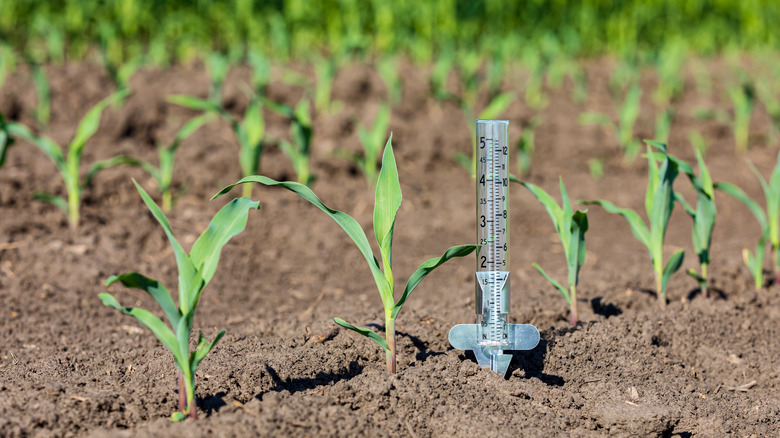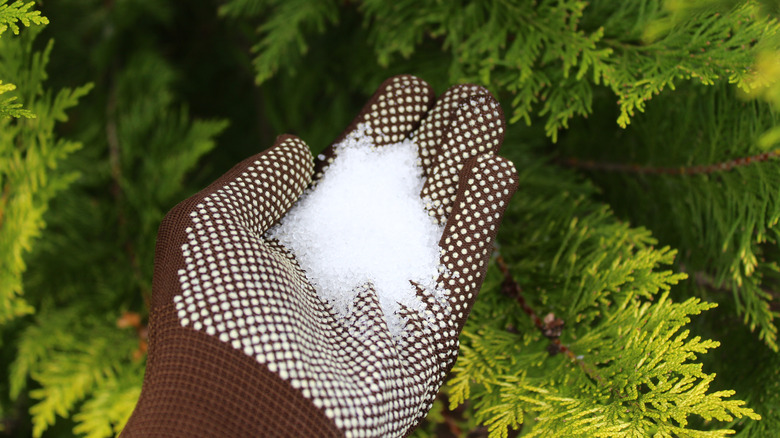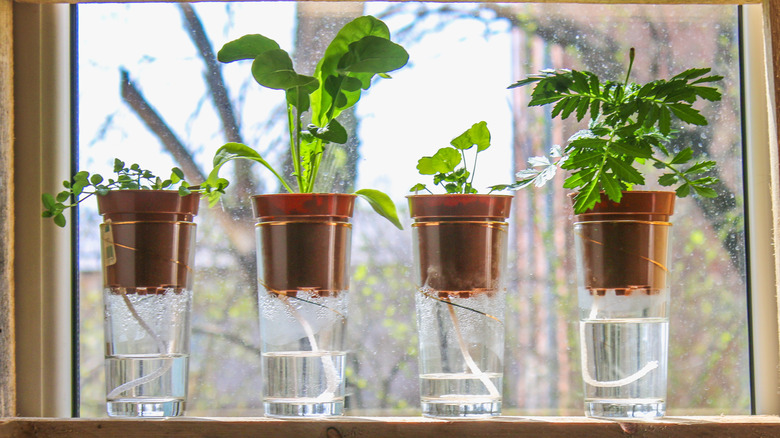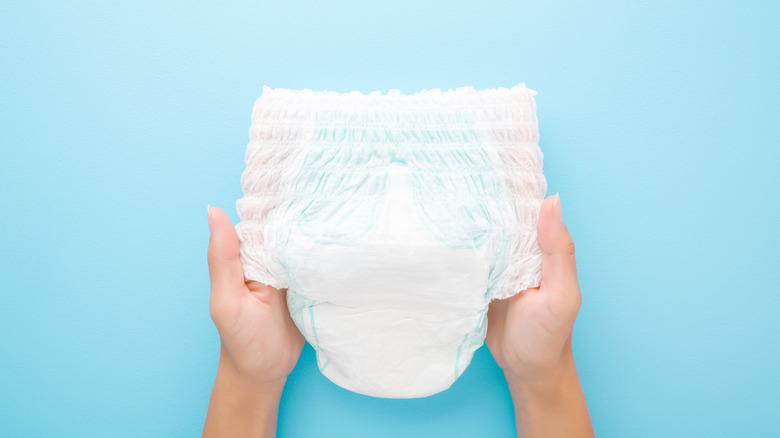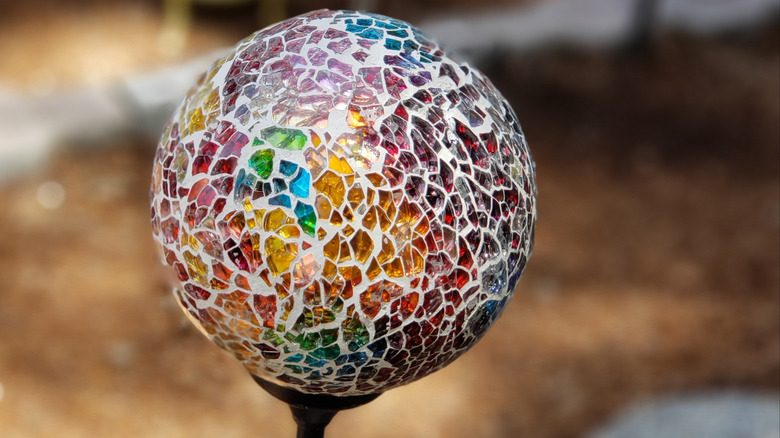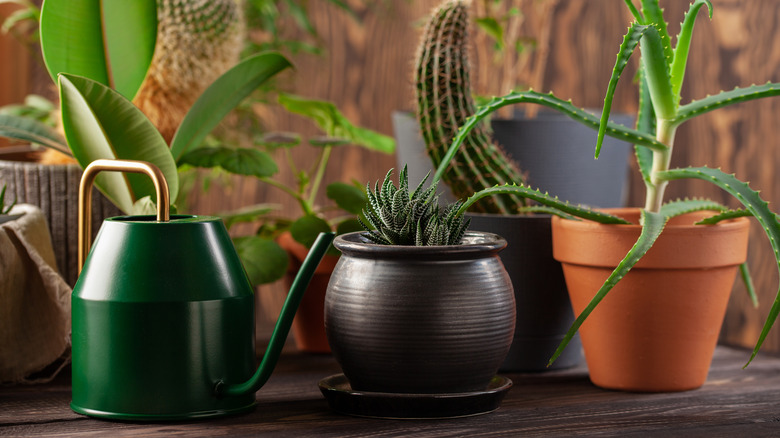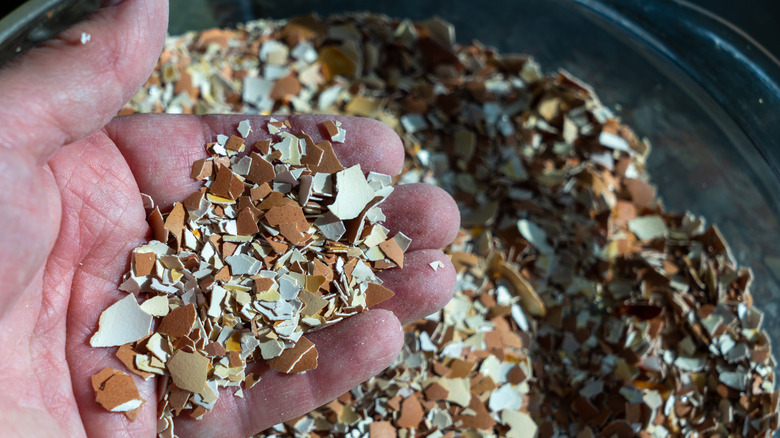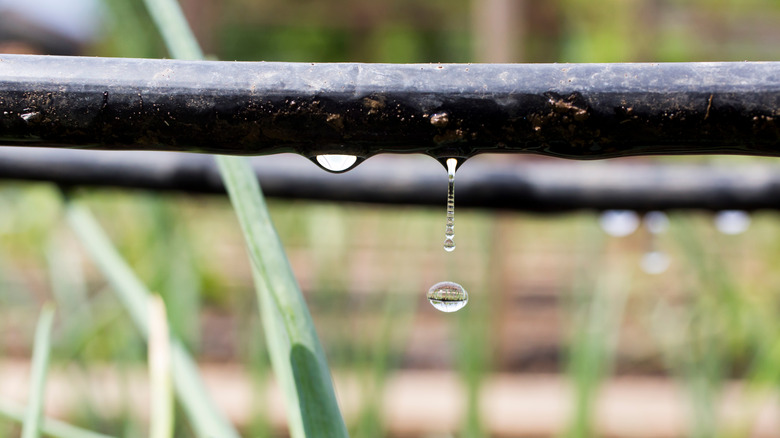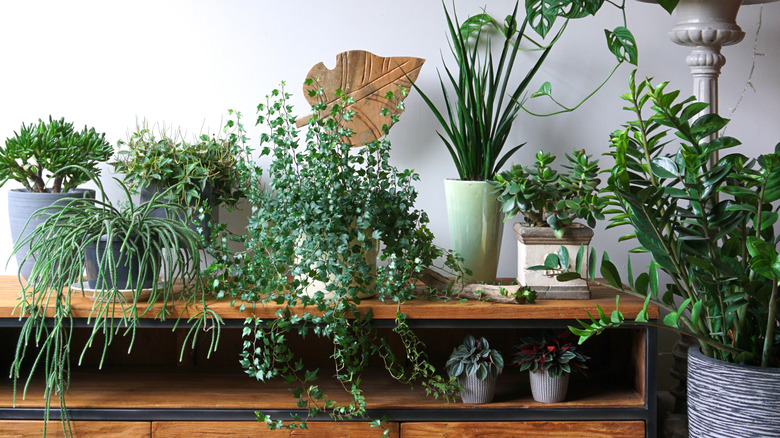15 Genius Tips For Watering Your Plants
We may receive a commission on purchases made from links.
Being a plant parent is, admittedly, tough work, as noted by NBC News. Either you're paying too close attention to your new houseplants (and subsequently drowning them with a whole lot of water and love — sorry, snake plant!), or you're not paying them any mind at all (and they're sucking down any water in their quickly drying soil in protest).
While there's certainly a fine line between being an observant plant owner and a worried over-waterer, caring for plants doesn't have to be rocket science. Whether you're trying to get a handle on your drab-looking indoor houseplants or your once green garden, there are plenty of tips and tricks that can make the watering process so much simpler (and trust us, you don't have to have a natural green thumb). Here are some of our favorite genius gardening secrets and watering hacks to get the most life out of your precious plants as possible!
1. Always water in the morning
Maybe this isn't as easy to implement in practice — who wants to put in some quick garden labor before a morning commute, after all — but try to prioritize watering your plants first thing in the morning.
Southern Living says your plants will hold onto the moisture better, and they'll be freshly watered and ready for the hot sun and stress of the day. By the time night rolls around, any water that hasn't been soaked by the soil will have evaporated, and the plant's leaves will be dry, rendering them less susceptible to disease and rotting.
2. Water from the roots
For potted indoor houseplants especially, try watering from the base instead. One would think the leaves need a good soak to stay lusciously green, but really, it's all in the roots. This technique allows your plants to slowly soak in water from the soil, as opposed to having it trickle down.
Make sure your plant has a drainage hole at the base of the pot before trying this method. If it does, then pour the water directly at the root, lightly soaking the soil. The plant can then continuously absorb moisture as needed, and this will prevent overwatering rot-prone areas, says Longfield Gardens.
3. Use warm water
Cold water may be synonymous with all things refreshing, but it's actually not the best for reviving plants! Surprisingly, warm water is actually the temperature to shoot for when caring for plants.
The Sill suggests using warm water because it's the most agreeable when it comes time to absorb into the soil, and will lead to less runoff. This will ultimately provide more nutrients, since the soil will stay soaked through for longer. So if you want to get the most bang for your buck each watering session, leave the tap or hose on a bit longer before filling up!
4. Keep a closer eye the soil
Many plant owners make the mistake of glancing at their soil, seeing moisture, and assuming the best. If the top is wet, then the whole pot must be, right? Unfortunately not — that's why it's crucial to keep tabs on the extent of your soil's moisture levels using some sort of object to see just how saturated it is.
The opposite scenario is also bound to happen, where soil looks dry, but it's actually moist towards the roots. Bob Vila recommends having a wooden dowel on hand, which you can easily stick down a few inches into the dirt — if the dowel has soil on it when you pull it out, then your plant is sufficiently watered. If it turns up completely clean, then the soil needs another soak.
5. Try a watering wand
If you're going to water your plants from the top down, try swapping harsher nozzles for a watering wand, which will solve a whole slew of plant problems for you!
The podcast Spoken Garden breaks down the pros of a watering wand over a spray nozzle; it actually works like natural rain would, since it consistently sprays water without too much pressure. This will prevent any over-saturation and lengthen the life of your plant. Even better? It acts as an extender to water high up hanging flowers, or anything elevated and out of reach.
6. Soak your plants in the sink
If you have some needier plants that require frequent watering, but you're headed out of town, don't panic. All you have to do is fill a sink in a naturally lit area and lay a sheet on the bottom to protect it, then place your plants on top.
The plant will slowly drink up the bit of water surrounding it, which will act as a bottom watering system while you're away. Don't try this out if you'll be away from your plants for longer than a week, or you risk falling behind on your plant's watering needs, per cNet.
7. Get a soil gauge
If the wooden dowel trick seems too old school for your gardening style, there are also automated ways that may bring your watering game straight into this year. Gardener's Supply Company recommends stocking your toolkit with a soil moisture sensor.
This automatic system not only operates on a timer, but it also detects rain and holds off to avoid over-watering your plants. If you're constantly wondering whether your soil is teetering on the line between too wet and not wet enough, splurging on a system like this takes the headache out of gardening and plant care altogether.
8. Mix in some Epsom salt
Epsom salt, or magnesium sulfate, is actually filled with benefits and minerals that allows it to act as a superfood, reports Bob Vila. Simply mix 1 tablespoon with about 4 cups of water in a spray bottle and mist your plants.
According to the outlet, this combo actually helps bring out the vibrancy in plant leaves again, so it's a great shake-up if your plants are looking dull. Epsom salts also naturally keep away pests, which can help prevent root rot and disease, and improve nutrient absorbency when applied to plants twice a month.
9. Try wicking while you're away
Going on vacation doesn't have to mean inevitable death for your plants. You've probably seen this trick before, and that's because it's an old, tried, and true watering secret.
All you have to do is fill a clean bucket with some warm water, and cut a long piece of cotton clothesline or rope, says cNet. Place one end deep into the soil of your potted plant, and submerge the other in your water container, making sure it touches the bottom. The rope will act as a steady way to water your plant, so long as the bucket is filled.
10. Place a diaper under potted plants
Water hydrating crystals act as a means to absorb and hold onto some of the water you add to a plant, so that it can disperse it as needed later. At nearly $12 per bag (like for this one from Miracle-Gro), you're definitely paying a premium, but you don't even have to — you can get the same benefits with something many families already have at home.
Diapers actually contain similar polymer crystals. All you have to do is open up a clean diaper, poke some holes in it, and place it at the bottom of your pot, below the soil, but on top of some bark or mulch. Sunday Gardener says that the diaper will expand and become a reservoir for any water before the excess drains out, so your plant will be less at risk of drying out.
11. Get a gradual flow device
You've probably stumbled upon gradual flow devices in some soil before — they're small, stained glass bulbs that look like globe thermometers. You can snag a set on Amazon for under $15, or check out your local garden center.
According to New England Today, it's a simple process: Fill the orbs with water and insert them into the soil. The angled bottom will evenly disperse water over time. You won't have to water your plants on the regular, the moisture is directed straight to the soil and root of the plant, and they function as an accent piece.
12. Watch your water collection trays
If the houseplant that you're watering has drainage at the bottom, be sure to check in on it often. There's a happy medium between a full water tray and a water tray that's been full for too long — both are beneficial, but only to an extent.
A full water tray means you may have over-watered a bit. Don't let it sit for too long, or this may cause root rot. However, you don't want to dump the collection tray immediately, either; this is because the plant may slowly reabsorb some of that water over the next half an hour, if it needs it. Circle back after about 30 minutes and see how much water is left, and then dispose of it to prevent any lasting damage, instructs Bob Vila.
13. Use eggshell water
We know the benefits of Epsom salts, but now we're showing our hand (green thumb and all) with an even better kept gardening secret: eggs! The blog Flourishing Plants breaks down the plant-friendly benefits of eggshells, explaining that they're rich in amino acids, calcium, and minerals. Incorporating eggshells into your watering regimen will help strengthen your plant's stems and minimize the need for fertilizer.
Grab a container of rainwater (or regular water, but the rainwater will have some added minerals). Accumulate your egg shells throughout that week's breakfasts, and then toss them in the water to bring to a boil. After boiling the water for about 45 minutes, skim off the film at the top, toss any remaining shells, let it cool, then get watering!
14. DIY a drip irrigation system
Sure, a sprinkler system works wonders, but it turns out that even a DIY drip irrigation system gets the job done even better when it comes time to water your outdoor plants. DIY Network even says that the former is only 70% to 80% effective, while an at-home drip irrigation solution is upwards of 90% effective.
You'll need some above ground tubing and the appropriate tools like wire cutters, but be sure to check what's underground before you start digging. Once that's clear, lay and connect some small tubes to a main line tube along the tree line or plant line. Stake down the tubing, but don't bury it (that's a recipe for disaster when it comes to nosy garden animals). Hook it up to your irrigation and let your DIY project do all the watering work for you from here on out!
15. Know the age of your plant
You should adapt your methods and techniques depending on the age of your plant, if you want it to respond best to your watering routine. Southern Living explains that older, mature plants that have been in your yard longer don't need as frequent attention, even if they once did. Instead, they'll need a more substantial soaking less often, as time goes on and those older plants age.
Younger, freshly planted additions, however, need to be watered more regularly. In order to encourage the best root system, you'll want to keep up with them and be extra careful not to over-saturate. Always keep the age of a plant in mind before you treat your entire garden the same!
